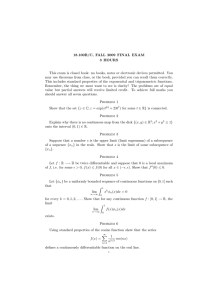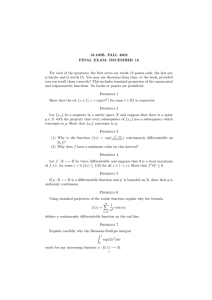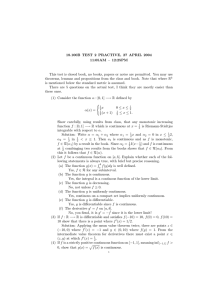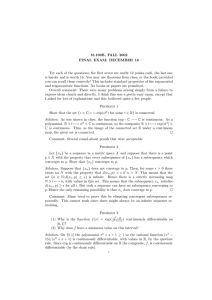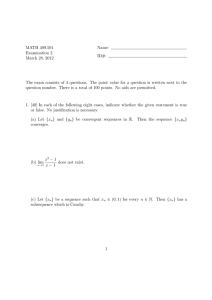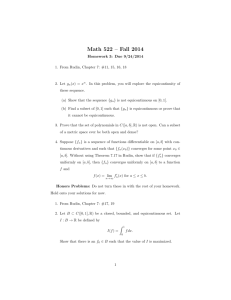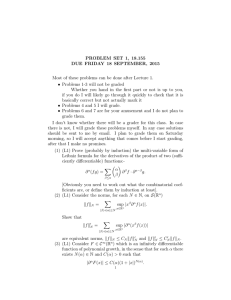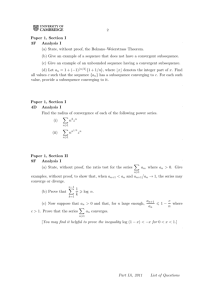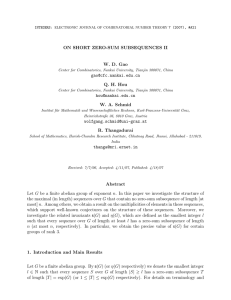18.100B/C, FALL 2009 FINAL EXAM, SOLUTIONS
advertisement
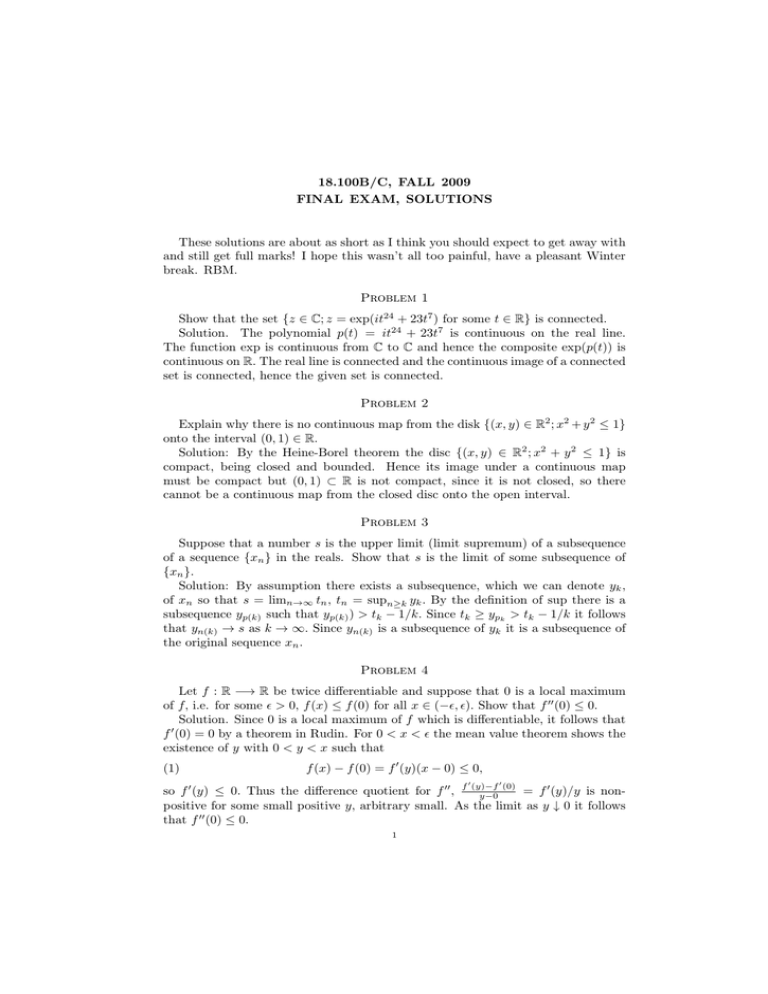
18.100B/C, FALL 2009
FINAL EXAM, SOLUTIONS
These solutions are about as short as I think you should expect to get away with
and still get full marks! I hope this wasn’t all too painful, have a pleasant Winter
break. RBM.
Problem 1
Show that the set {z ∈ C; z = exp(it24 + 23t7 ) for some t ∈ R} is connected.
Solution. The polynomial p(t) = it24 + 23t7 is continuous on the real line.
The function exp is continuous from C to C and hence the composite exp(p(t)) is
continuous on R. The real line is connected and the continuous image of a connected
set is connected, hence the given set is connected.
Problem 2
Explain why there is no continuous map from the disk {(x, y) ∈ R2 ; x2 + y 2 ≤ 1}
onto the interval (0, 1) ∈ R.
Solution: By the Heine-Borel theorem the disc {(x, y) ∈ R2 ; x2 + y 2 ≤ 1} is
compact, being closed and bounded. Hence its image under a continuous map
must be compact but (0, 1) ⊂ R is not compact, since it is not closed, so there
cannot be a continuous map from the closed disc onto the open interval.
Problem 3
Suppose that a number s is the upper limit (limit supremum) of a subsequence
of a sequence {xn } in the reals. Show that s is the limit of some subsequence of
{xn }.
Solution: By assumption there exists a subsequence, which we can denote yk ,
of xn so that s = limn→∞ tn , tn = supn≥k yk . By the definition of sup there is a
subsequence yp(k) such that yp(k) ) > tk − 1/k. Since tk ≥ ypk > tk − 1/k it follows
that yn(k) → s as k → ∞. Since yn(k) is a subsequence of yk it is a subsequence of
the original sequence xn .
Problem 4
Let f : R −→ R be twice differentiable and suppose that 0 is a local maximum
of f, i.e. for some > 0, f (x) ≤ f (0) for all x ∈ (−, ). Show that f 00 (0) ≤ 0.
Solution. Since 0 is a local maximum of f which is differentiable, it follows that
f 0 (0) = 0 by a theorem in Rudin. For 0 < x < the mean value theorem shows the
existence of y with 0 < y < x such that
(1)
f (x) − f (0) = f 0 (y)(x − 0) ≤ 0,
0
0
(0)
= f 0 (y)/y is nonso f 0 (y) ≤ 0. Thus the difference quotient for f 00 , f (y)−f
y−0
positive for some small positive y, arbitrary small. As the limit as y ↓ 0 it follows
that f 00 (0) ≤ 0.
1
2
18.100B/C, FALL 2009 FINAL EXAM, SOLUTIONS
Problem 5
Let {φn } be a uniformly bounded sequence of continuous functions on [0, 1] such
that
Z 1
xk φn (x)dx = 0
(2)
lim
n→∞
0
for every k = 0, 1, 2, . . . . Show that for any continuous function f : [0, 1] → R, the
limit
Z 1
f (x)φn (x)dx
lim
n→∞
0
exists.
Solution: Since any polynomial is a finite sum of products of monomials xk and
constants it follows from (2) that
Z 1
Z 1
N
X
p(x)φn (x)dx =
xk φn (x)dx = 0
(3)
lim
ck lim
n→∞
0
k=1
n→∞
0
for any polynomial p.
The uniform boundedness means that there exists a constant M such that
|φn (x)| ≤ M for all n and for all x ∈ [0, 1]. Given a continuous function f : [0, 1] −→
C, the Stone-Weierstrass Theorem shows that there is a sequence of polynomials
pl (x) converging uniformly to f on [0, 1]. Thus, given > 0, there is a polynomial
p such that
Z 1
Z 1
(4) |p(x) − f (x)| < /2(M + 1) =⇒ |
f (x)φn (x)dx −
p(x)φn (x)dx| < /2.
0
0
Now, since p is a polynomial, (3) shows the existence of N such that
Z 1
Z 1
(5)
n > N =⇒ |
p(x)φn (x)dx| < /2 =⇒ |
f (x)φn (x)dx| < .
0
Thus limn→∞
R1
0
0
f (x)φn (x)dx = 0 for any continuous function f on [0, 1].
Problem 6
Using standard properties of the cosine function show that the series
f (x) =
∞
X
1
cos(nx)
5/2
n
n=1
defines a continuously differentiable function on the real line.
Solution: The terms in the series are all differentiable with derivatives
1
(6)
− 3/2 sin(nx).
n
Since | sin(nx)| ≤ 1 this P
series is absolutely and uniformly convergent on R, by
the comparison test with
n−3/2 . The same applies to the original series so, by a
n
theorem in Rudin, the sum f is differentiable on R and the derivative is the sum of
a uniformly convergent series of continuous functions, hence continuous. Thus f is
continuously differentiable as a function on R.
18.100B/C, FALL 2009
FINAL EXAM, SOLUTIONS
3
Problem 7
(1) Explain why the Riemann-Stieltjes integral
Z 1
(7)
exp(x2 /3)dα
−1
exists for any increasing function α : [−1, 1] −→ R.
(2) Evaluate this integral when
(
0 x<0
α=
1 x ≥ 0.
Solution: By a theorem in Rudin any continuous function is Riemann-Stieltjes
integrable with respect to any increasing function α. Since exp(x2 /3) (or was it
2
supposed to be exp(x 3 )?) is continuous, as the composite of continuous functions,
the integral (7) exists.
To compute it, consider the partition with two interior division points at −δ and
δ, where δ > 0 is small. The upper and lower Riemann-Stieltjes sums are then
(8)
inf exp(x2 /3)(α(δ) − α(−δ)) and sup exp(x2 /3)(α(δ) − α(−δ)).
[−δ,δ]
[−δ,δ]
As δ → 0 these both approach 1 which must therefore be the value of the integral
Z 1
(9)
exp(x2 /3)dα = 1.
−1
[Or by quoting some other result from Rudin.]
